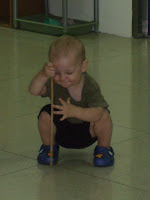Yes, avoision!
How’s it going in enterovirus-ville?
Well, it’s going ok.
It’s not 100% convenient keeping the boys home from daycare – but we’re doing it. Any lingering doubts as to whether we are over-reacting were banished when our friend called up this morning to say her son’s class at Wagor has been closed for ten days due to enterovirus. Oh, and, so, by the way, he’ll be going to Baby World during that time. She didn’t want me to worry.
Now, as I mentioned last time I wrote about EV71, I’m not a doctor, nor am I a scientist, so, please, please, please correct me if I’m misunderstanding something. I just assumed that suspending classes is intended to halt the spread of a disease by keeping the exposed children HOME. Is it really ok to plop a kid whose class has been closed due to enterovirus into a whole different school with all different kids? My gut says no, my brain says no. My guts and brain also agree that my friend is not the only one doing this.
My other area of uncertainty regards definitive diagnosis of EV71, especially in light of its 3-7 day incubation period. As far as I understand, in part because the disease plays out differently from case to case, diagnosis requires lab testing, the results of which take day(s) to receive. So is it really possible to definitively say that a 3-1/2 year old who has been in a xiao ban class with other same-aged kids, who all eat and sleep - not only together - but in the same space, in a classroom adjacent to a bathroom where toilet paper is put into garbage cans, isn’t carrying the virus? Each classmate of an infected student must be seen by a dr every day for a week. So they’re all going to a public place with sick people, thereby increasing their chances of exposure, everyday to be visually assessed? How do drs make their determinations? I don’t get it.
But I’m not a doctor.
Here is EV71 news:
· Articles from a search on Taiwanheadlines.com
· From today’s China Post, 204 enterovirus infections confirmed this year: CDC
Here is some EV71 background:
· From the Journal of Clinical Microbiology, Evaluation of Different Clinical Sample Types in Diagnosis of Human Enterovirus 71-Associated Hand-Foot-and-Mouth Disease
· The Enterovirus – Non-Polio entry from WHO
· According to the Swiss,
Clinical presentation: After an incubation period of 3 to 7 days, symptoms
start with fever, and general malaise. After 2 days, this is followed by the
development of sores (blisters, ulcers) on the tongue, gums and inside the
cheeks and a skin rash on the palms of the hands and the soles of the feet.
Symptoms usually disappear after a week to 10 days. Young children are the most
affected. A large proportion, more than two thirds of enterovirus 71 infected
cases remain asymptomatic. While enterovirus 71 infections are most frequently
self-limited febrile diseases, they may cause severe neurological disease,
including viral (aseptic) meningitis, encephalitis or acute flaccid paralysis.
As illustrated during a recent large outbreak in Taiwan, death may occur, mainly
in children below three years, as well as long-term neurological
sequelae.
Transmission modes: Enterovirus 71 is mainly transmitted through direct
contact with nose and throat discharges, fluid from the blisters, saliva or
through faeco-oral route. In case of respiratory illness, transmission through
droplets may also occur. There is no evidence of food- or water-borne
transmission
Pics of Burl at my school yesterday – You can see him wearing both pairs of his new shoes as well as playing with the dowel I took away...



 Click on pics to make them BIGGER.
Click on pics to make them BIGGER.


No comments:
Post a Comment